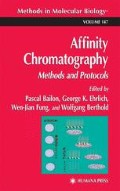Abstract
Biopolymers can be separated by partitioning between two aqueous phases generated by two polymers dissolved together in water (1,2). The partitioning of proteins and nucleic acids between the two phases may be affected by changing the concentration of polymers, usually dextran and polyethylene glycol (PEG), and by including various salts and adjusting the pH value of the system (1,3). A more effective way to adjust the partitioning and also to strongly increase the selectivity in the partitioning of biopolymers has been to bind charged groups, hydrophobic groups, or affinity ligands to one of the polymers that localizes the attached groups to the phase enriched in this polymer (4–6). Mainly by using a variety of methods, affinity ligands have been bound to PEG, concentrated in the top phase (7). However, dextran has been used also as ligand carrier for affinity partitioning (8). Affinity partitioning can be used both for single-step extractions (9) and for countercurrent distribution (10). The two-phase systems can be applied in chromatographic processes by adsorbing one of the phases to a matrix and using the other one as the mobile phase (11). Besides the extraction and separation of proteins (6,12) and nucleic acids (13), affinity partitioning also has been used for fractionation of particulate biomaterials such as membranes (14–16).
Access this chapter
Tax calculation will be finalised at checkout
Purchases are for personal use only
References
Albertsson P.-Å. (1986) Partition of Cell Particles and Macromolecules, 3rd ed., Wiley, New York.
Walter H. and Johansson G., eds. (1974) Methods in Enzymology, vol. 228, Aqueous Two-Phase Systems, Academic San Diego, CA.
Johansson G. (1974) Partition of proteins and micro-organisms in aqueous biphasic systems. Mol. Cell. Biochem. 4, 169–180.
Johansson G., Hartman A., and Albertsson P.-Å. (1973) Partition of proteins in two-phase systems containing charged poly(ethylene glycol). Eur. J. Biochem. 33, 379–386.
Johansson G. (1994) Uses of poly(ethylene glycol) with charged or hydrophobic groups, in Methods in Enzymology, vol. 228, Aqueous Two-Phase Systems (Walter H. and Johansson G., eds.) Academic San Diego, CA, pp. 64–74.
Kopperschläger G. and Birkenmeier G. (1990) Affinity partitioning and extraction of proteins. Bioseparation 1, 235–254.
Harris J. M. (1985) Laboratory synthesis of polyethylene glycol derivatives. J. Macromol. Sci., Rev. Polym. Chem. Phys. C25, 325–373.
Johansson G. and Joelsson M. (1987) Affinity partitioning of enzymes using dextran-bound Procion yellow HE-3G. Influence of dye-ligand density. J. Chromatogr. 393, 195–208.
Tjerneld F., Johansson G., and Joelsson M. (1987) Affinity liquid-liquid extraction of lactate dehydrogenase on a large scale. Biotechnol. Bioeng. 30, 809–816.
Johansson G. (1995) Multistage countercurrent distribution, in The Encyclopedia of Analytical Science (Townshend A., ed.), Academic London, pp. 4709–4716.
Müller W. (1994) Columns using aqueous two-phase systems, in Methods in Enzymology, vol. 228, Aqueous Two-Phase Systems (Walter H. and Johansson G., eds.) Academic San Diego, CA, pp. 100–112.
Johansson G., Kopperschläger G., and Albertsson P.-Å. (1983) Affinity partitioning of phosphofructokinase from baker’s yeast using polymer-bound Cibacron blue F3G-A. Eur. J. Biochem. 131, 589–594.
Müller W. (1985) Partitioning of nucleic acids, in Partitioning in Aqueous Two-Phase Systems. Theory, Methods, Uses, and Applications to Biotechnology. (Walter H., Brooks D. E., and D. Fisher, eds.), Academic, Orlando, FL, pp. 227–266.
Flanagan S. D. and Barondes S. H. (1975) Affinity partitioning—a method for purification of proteins using specific polymer-ligands in aqueous polymer two-phase systems. J. Biol. Chem. 250, 1484–1489.
Olde B. and Johansson G. (1985) Affinity partitioning and centrifugal countercurrent distribution of membrane-bound opiate receptors using Naloxone poly(ethylene glycol). Neuroscience 15, 1247–1253.
Persson A., Johansson B., Olsson H., and Jergil B. (1991). Purification of rat liver plasma membranes by wheat-germ-agglutinin affinity partitioning. Biochem. J. 273, 176,177.
Johansson G. (1976) The effect of poly(ethyleneglycol) esters on the partition onproteins and fragmented membranes in aqueous biphasic systems. Biochim. Biophys.Acta 451, 517–529.
Johansson G. (1988) Separation of biopolymers by partition in aqueous two-phase systems. Sep. Purific. Methods 17, 185–205.
Johansson G. and Joelsson M. (1986) Liquid-liquid extraction of lactate dehydrogenase from muscle using polymer-bound triazine dyes. Appl. Biochem. Biotechnol. 13, 15–27.
Åkerlund H.-E. and Albertsson P.-Å. (1994). Thin-layer countercurrent distribution and centrifugal countercurrent distribution apparatus, in Methods in Enzymology, vol. 228, Aqueous Two-Phase Systems (Walter H. and Johansson G., eds.) Academic, San Diego, CA, pp. 87–99.
Johansson G., Andersson M., and Åkerlund H.-E. (1984). Counter-current distribution of yeast enzymes with polymer-bound triazine dye affinity ligands. J. Chromatogr. 298, 483–493.
Bradford M. M. (1983) A rapid and sensitive method for the quantitation of microgram quantities of protein utilizing the principle of dye binding. Anal. Biochem. 72, 248–254.
Zaslavsky B. Y. (1995). Aqueous Two-Phase Partitioning: Physical Chemistry and Bioanalytical Applications, Marcel Dekker New York.
Author information
Authors and Affiliations
Editor information
Editors and Affiliations
Rights and permissions
Copyright information
© 2000 Humana Press Inc.
About this protocol
Cite this protocol
Johansson, G. (2000). Affinity Partitioning of Proteins. In: Bailon, P., Ehrlich, G.K., Fung, WJ., Berthold, W. (eds) Affinity Chromatography. Methods in Molecular Biology, vol 147. Humana Press. https://doi.org/10.1007/978-1-60327-261-2_11
Download citation
DOI: https://doi.org/10.1007/978-1-60327-261-2_11
Publisher Name: Humana Press
Print ISBN: 978-0-89603-694-9
Online ISBN: 978-1-60327-261-2
eBook Packages: Springer Protocols

